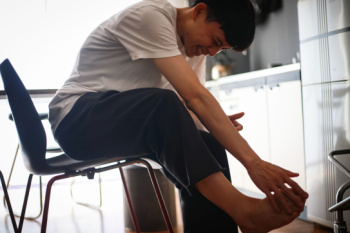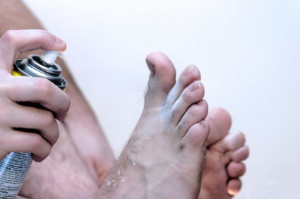
Proper foot care is crucial for individuals managing diabetes. Maintaining good hygiene by washing and drying feet daily helps prevent infections. Regular foot exams are essential for checking for cuts, blisters, or other abnormalities. Monitoring blood glucose levels consistently aids in effective diabetes management and reduces the risk of foot-related issues. Diabetic neuropathy and poor circulation can lead to foot problems such as ulcers or infections, necessitating immediate attention. Chiropodists specialize in foot care and can offer valuable assistance. They provide guidance on proper footwear, offer preventive measures, and promptly treat any foot ailments. Chiropodists conduct comprehensive foot exams, identifying potential problems early on. If you have diabetes, it is strongly suggested that you schedule regular appointments with a chiropodist for specialized care to mitigate risks and ensure optimal foot health.
Diabetes can cause serious problems in the lower limbs if proper preventive measures are not taken and diabetic wound care is not performed. If you would like to learn more about caring for diabetic feet, please consult with Chiropodist Stephanie Poupore from North Bay Foot & Ankle. Our clinician can help you maintain the health of your lower limbs and your mobility.
Diabetes can lead to a host of foot and ankle complications, including:
-
Poor circulation
-
Peripheral neuropathy
-
Diabetic foot wounds and ulcers
-
Infection
-
Corns and calluses
-
Dry, cracked skin
-
Nail disorders
-
Hammertoes
-
Bunions
-
Charcot foot
If you have diabetes, you must be vigilant of any changes in your foot health. This is best done through daily foot inspections. Using a mirror to help you if necessary, look for any:
-
Cuts, scrapes, sores, or wounds
-
Bruising or discoloration
-
Swelling
-
Rash
-
Foul odor
-
Nail changes
-
Hair loss
-
Warmth and inflammation
-
Deformities
-
Lower limb pain
-
Strange sensations (numbness, tingling, burning, pins, and needles)
If you detect anything unusual, seek the care of a chiropodist as soon as possible. If you have any questions, please feel free to contact our office located in . We offer the newest diagnostic and treatment technologies for all your foot care needs.

Gout in the feet can be excruciating, often characterized by sudden, intense pain, swelling, redness, and warmth in the affected joint, commonly the big toe. It is a type of arthritis caused by the buildup of uric acid crystals in the joints, leading to inflammation and severe discomfort. Gout typically occurs when the body produces excessive uric acid or has difficulty eliminating it, resulting in high levels in the blood. Factors such as diet, genetics, obesity, and certain medications can contribute to gout flare-ups. Treatment options for gout include medications to reduce inflammation and uric acid levels, lifestyle modifications such as dietary changes, and weight and pain management strategies. A chiropodist can assist by providing education on gout management, evaluating foot health, recommending appropriate footwear, and offering interventions to alleviate pain and improve joint function, contributing to better overall foot health and quality of life. If you have had one or more gout attacks, it is suggested that you are under the care of a chiropodist who can help you with management techniques.
Gout is a painful form of arthritis that can affect anyone. Please consult with Chiropodist Stephanie Poupore from North Bay Foot & Ankle. Our clinician will assess your condition and provide you with quality foot and ankle treatment.
What Is Gout?
Gout is characterized by sudden, severe attacks of pain, redness, and tenderness in the joints. This type of arthritis is caused by a buildup of uric acid in the bloodstream. When uric acid crystallizes in a joint, often the joint of the big toe, it can bring about a gout attack.
Symptoms
Symptoms of gout include:
-
Sudden and severe pain
-
Swelling
-
Redness
-
Warmth
-
Joint stiffness
-
Joint deformity
Diagnosis
A chiropodist will ask questions about your personal and family medical history, followed by an examination of the affected joint. Laboratory tests and x-rays are sometimes ordered to determine if the inflammation is caused by something other than gout. A sample of fluid taken from your joint can show whether it contains uric acid.
Treatment
Prescription medications or injections are used to treat the pain, swelling, and inflammation. Patients with chronic gout can also use behavioral modifications such as diet, exercise, and decreased intake of alcohol to help minimize the frequency of gout attacks. Foods and beverages that are high in purines should be avoided since purines are converted in the body to uric acid. If left untreated, this painful condition can leave your joint permanently damaged and swollen.
If you have any questions, please feel free to contact our office located in . We offer the newest diagnostic and treatment technologies for all your foot care needs.

Athlete's foot, medically known as tinea pedis, is a common fungal infection affecting the skin of the feet. This condition thrives in warm, moist environments, making sweaty socks and tight shoes ideal breeding grounds for the fungus. Symptoms include itching, burning, and cracked, peeling skin, often between the toes or on the soles of the feet. To prevent athlete's foot, it is essential to keep feet clean and dry, especially after swimming or sweating. Wearing breathable footwear and changing socks regularly can help minimize moisture buildup. Additionally, avoiding walking barefoot in public places like locker rooms or communal showers reduces the risk of exposure to the fungus. Proper foot hygiene, such as washing feet daily with soap and water and thoroughly drying them afterward, is vital. When using communal facilities, wear protective footwear like flip-flops to provide an extra layer of defense. If you have developed athlete’s foot, it is suggested that you visit a chiropodist who can offer you effective treatment remedies, which may include prescribed medication.
Athlete’s foot can be uncomfortable and unsightly. To learn more about preventing and treating this condition, please consult with Chiropodist Stephanie Poupore from North Bay Foot & Ankle. Our clinician will assess your condition and provide you with quality foot and ankle treatment.
What Is Athlete’s Foot?
Athlete’s foot refers to an infection of the skin on the feet that is caused by a fungus. This fungus is contagious and thrives in warm and moist environments. It is often spread in common areas such as public pools, locker rooms, and showers. It can also spread when sharing personal items, like shoes or towels, with an infected person.
Symptoms
The symptoms of athlete’s foot may include:
-
Itching, stinging, or burning of the skin on the feet
-
Cracking or peeling skin, especially between the toes and on the soles of the feet
-
Scaly, red rash on the foot
-
Blisters
-
Foul odor
Treatment
Treatment for athlete’s foot typically involves using over-the-counter topical antifungal medications on the feet. When over-the-counter options are ineffective, you may need to take prescription oral medications or topical antifungal drugs, or a combination of both.
Prevention
Preventing athlete’s foot places an emphasis on good foot hygiene practices.
You can prevent athlete’s foot by:
-
Washing and drying your feet thoroughly every day
-
Wearing shoes when walking in public areas
-
Not sharing personal items, like shoes or socks, with others
-
Wearing shoes and socks made out of breathable materials
If you have any questions, please feel free to contact our office located in . We offer the newest diagnostic and treatment technologies for all your foot care needs.

